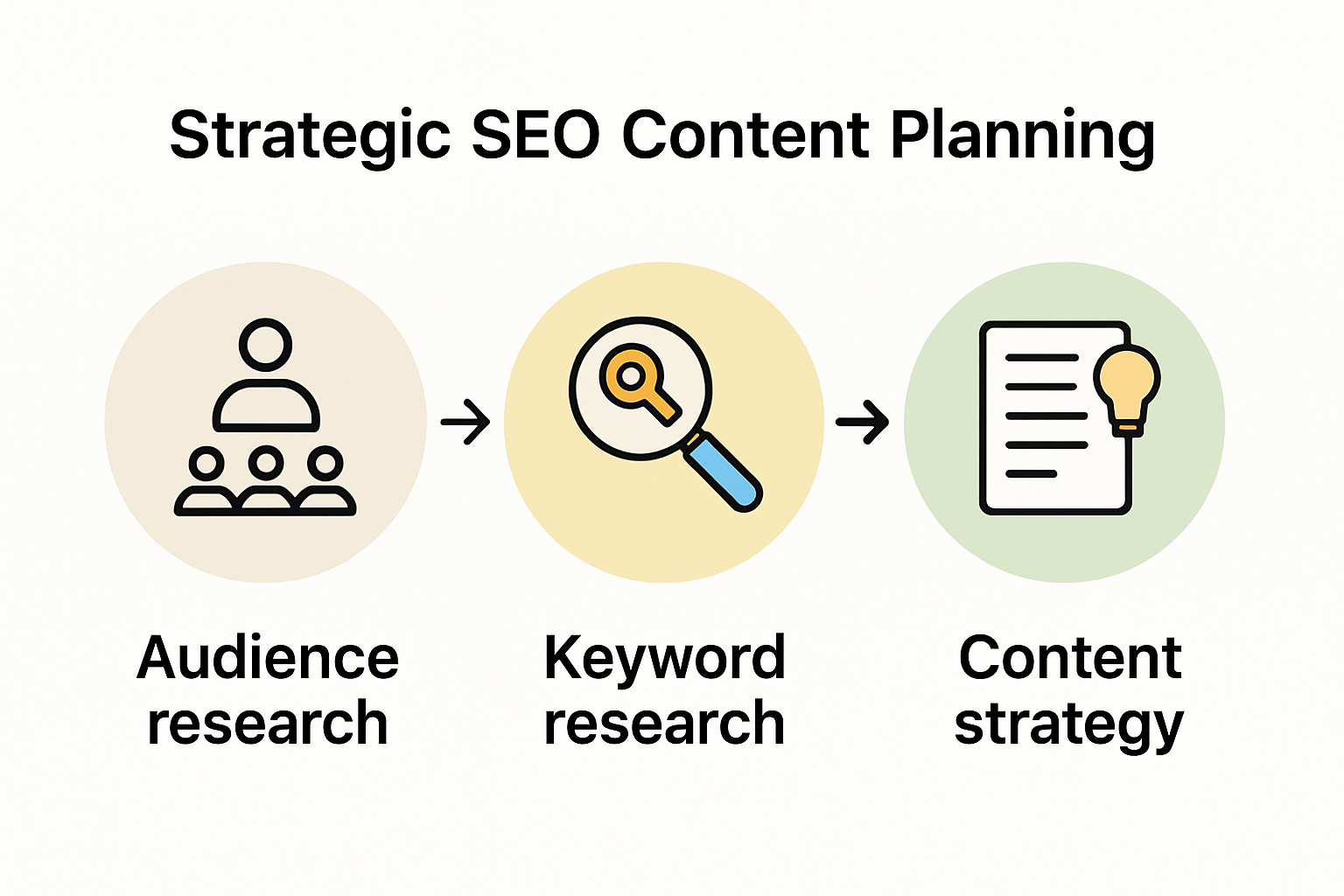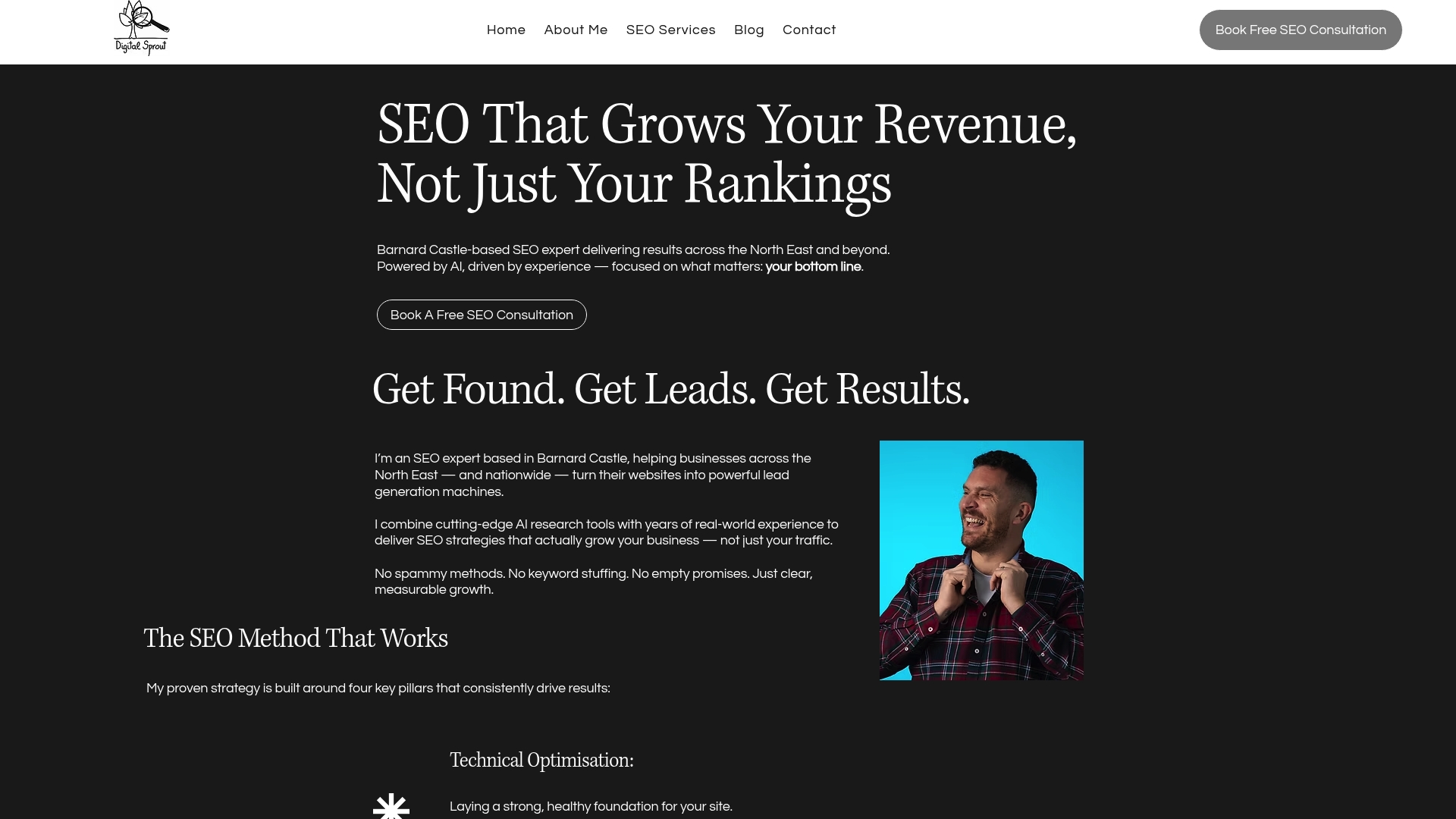SEO Content Planning for 2025: A Guide for Growing Businesses
- Mike Dodgson

- Jun 20
- 8 min read
Updated: Jun 22
SEO content planning will make or break business growth in 2025. Here is something many overlook. Nearly 70 percent of all web traffic starts with a search engine query, but simply publishing more blog posts will not help you thrive. The real impact comes from developing a strategy that treats content as a living, interconnected system. This modern approach flips outdated SEO tactics on their head and reveals opportunities for those ready to adapt.
Table of Contents
Quick Summary
Defining SEO Content Planning for Modern Businesses
The Core Components of Strategic SEO Content Planning
At its foundation, effective SEO content planning transcends traditional keyword stuffing and superficial content creation. Modern businesses must develop a holistic approach that integrates deep audience understanding, comprehensive keyword research, and a nuanced content strategy. This involves mapping out content that addresses specific user needs across different stages of their customer journey.
The process begins with rigorous audience research. You need to understand not just demographic information, but the precise questions, challenges, and motivations driving your potential customers. What problems are they seeking solutions for? What language do they use when searching? What type of content resonates most with them?

Creating a Purposeful Content Ecosystem
Successful SEO content planning requires viewing your digital content as an interconnected ecosystem rather than isolated pieces. Each piece of content should serve a strategic purpose: some designed to attract initial awareness, others to provide in-depth information, and some specifically crafted to drive conversational conversions. Explore our detailed SEO strategy guide to understand how these content elements work together.
Businesses must also recognize that SEO content planning is not a static process. Search algorithms continuously evolve, user behaviours shift, and competitive landscapes transform. Your content strategy must remain agile and responsive. This means regular content audits, performance analysis, and willingness to adapt your approach based on real-world data and emerging trends.
Key elements of a modern SEO content plan include:
- Comprehensive Keyword Research
: Identifying not just high-volume keywords, but understanding search intent and user journey
- Content Mapping
: Aligning content with specific customer journey stages and search intentions
- Performance Tracking
: Continuous monitoring of content performance across key metrics
By treating SEO content planning as a dynamic, strategic discipline, businesses can create a powerful digital presence that attracts, engages, and converts their ideal customers with precision and effectiveness.
Essential Steps to Create an Effective Content Plan
Creating an effective content plan requires a structured and methodical approach that goes beyond random content generation. Businesses must develop a strategic framework that aligns their content with specific business objectives, audience needs, and search engine optimization goals.
Conducting Comprehensive Audience Research
The foundation of any successful content plan starts with deep audience understanding. This means moving beyond basic demographic data and diving into detailed user personas that capture motivations, pain points, and search behaviours. You need to map out the entire customer journey, identifying the specific questions and challenges your audience encounters at each stage.
Utilize multiple research methods to build a comprehensive audience profile. This includes analysing website analytics, conducting customer surveys, reviewing social media interactions, and examining customer support queries. The goal is to create a nuanced understanding of your target audience that allows you to craft content that genuinely resonates.
Developing a Strategic Content Architecture

Once you understand your audience, the next step is to build a robust content architecture that supports your SEO and business objectives. Learn more about crafting strategic content approaches to ensure your efforts are targeted and effective.
This involves creating a content matrix that outlines:
- Content Types
: Blog posts, whitepapers, videos, infographics
- Keyword Targeting
: Primary and secondary keyword strategies
- Content Funnel Mapping
: Alignment with different stages of customer journey
- Frequency and Distribution
: Publishing schedule and content channels
A strategic content architecture ensures that each piece of content serves a specific purpose. Some content will aim to attract new audiences, while others will focus on nurturing existing leads or driving conversions. The key is creating a balanced ecosystem of content that supports your overall business goals.
Implementing Continuous Measurement and Optimization
An effective content plan is never static. It requires ongoing measurement, analysis, and refinement. Establish clear key performance indicators (KPIs) that go beyond simple traffic numbers. Look at metrics such as engagement rates, conversion rates, time on page, and content-driven revenue.
Regular content audits are crucial. Review your existing content quarterly to identify:
High-performing content that can be updated or repurposed
Content gaps in your current strategy
Opportunities for internal linking and content consolidation
Performance trends and emerging audience interests
By treating your content plan as a living, breathing strategy, you can ensure that your SEO efforts remain agile and responsive to changing market conditions and audience needs. This approach transforms content from a mere marketing tactic into a powerful business growth engine.
Choosing and Organising High-Impact Keywords
Keyword selection represents the strategic cornerstone of effective SEO content planning. Modern businesses must move beyond simplistic keyword targeting and develop a sophisticated approach that captures user intent, competitive landscape, and search engine algorithmic nuances.

Understanding Keyword Complexity and Intent
Successful keyword strategy requires a multidimensional perspective that goes far beyond search volume. You need to analyse keywords through multiple lenses: search intent, user journey stage, competition level, and potential conversion value. High-impact keywords are not just popular terms but strategic bridges connecting user needs with your business offerings.
Consider keywords as more than isolated phrases. They represent user conversations, pain points, and potential solutions. Some keywords indicate informational intent (users seeking knowledge), while others signal transactional intent (users ready to purchase). Your goal is to map keywords that align precisely with different stages of the customer journey.
Developing a Sophisticated Keyword Hierarchy
Discover advanced keyword optimization techniques to elevate your content strategy beyond basic targeting.
Create a structured keyword hierarchy that includes:
- Primary Keywords
: Core terms directly representing your main services or products
- Secondary Keywords
: Related terms that provide contextual depth
- Long-tail Keywords
: Specific, detailed phrases with higher conversion potential
- Semantic Keywords
: Conceptually related terms that demonstrate topical authority
This hierarchical approach allows you to create content that is not just keyword-rich but contextually comprehensive. By understanding keyword relationships, you can develop content that speaks directly to user needs while satisfying search engine ranking criteria.
Continuous Keyword Performance Evaluation
Keyword strategy is not a one-time activity but an ongoing process of research, implementation, and refinement. Implement a systematic approach to keyword performance tracking that goes beyond traditional metrics.
Regular keyword audits should examine:
Ranking performance across different search results
Click-through rates for specific keyword clusters
Conversion rates associated with keyword-targeted content
Emerging search trends and user behaviour shifts

By treating keywords as dynamic, evolving assets, businesses can maintain a competitive edge in their digital marketing efforts. The most successful SEO strategies recognize that keywords are living entities that reflect constantly changing user expectations and technological landscapes.
Remember that effective keyword organization is about creating a strategic ecosystem. Each keyword should serve a specific purpose within your broader content strategy, working synergistically to attract, engage, and convert your target audience with precision and relevance.
Measuring Results and Improving Your SEO Content
Measuring SEO content performance is not about collecting data but understanding the strategic insights that drive meaningful business growth. Modern businesses must develop a sophisticated approach to analytics that goes beyond surface-level metrics and delivers actionable intelligence.
Establishing Comprehensive Performance Metrics
Effective SEO content measurement requires a holistic view of performance that captures multiple dimensions of success. Traditional metrics like page views and rankings provide only a partial picture. You need to develop a nuanced framework that connects content performance directly to business objectives.
Key performance indicators should include:
- Conversion Rates
: Percentage of content visitors taking desired actions
- Engagement Metrics
: Time on page, scroll depth, interaction rates
- Revenue Attribution
: Direct and indirect revenue generated from content
- Organic Search Visibility
: Ranking improvements across targeted keywords
Advanced Content Performance Analysis
Explore our comprehensive guide to SEO performance tracking to unlock deeper analytical insights.
Content performance analysis requires moving beyond quantitative data to understand qualitative user experiences. Use tools that provide heat mapping, user journey tracking, and detailed behavioural analytics. This approach helps you understand not just how many people view your content, but how they interact with it and what motivates their engagement.
Implement a systematic content improvement process that includes:

Quarterly content performance reviews
Comparative analysis against industry benchmarks
User feedback integration
Continuous content refinement based on data insights
Strategic Content Optimization Cycles
Content optimization is an ongoing process of incremental improvements. Rather than making wholesale changes, focus on targeted refinements based on precise performance data. This might involve updating outdated information, improving readability, enhancing multimedia elements, or restructuring content to better match user intent.
Prioritize optimization efforts by:
Identifying underperforming content with high potential
Analyzing user feedback and search query data
Tracking emerging industry trends and search behaviours
Experimenting with content formats and presentation styles
Remember that SEO content is a dynamic ecosystem. Successful businesses treat their content as a living asset that continuously evolves to meet changing user needs and search engine algorithms. By adopting a data-driven, strategic approach to content measurement and improvement, you can transform your SEO efforts from a passive marketing activity into a powerful engine of business growth and customer engagement.
Frequently Asked Questions
What is SEO content planning?
SEO content planning is a strategic approach that involves creating content that satisfies user search intent while meeting search engine ranking requirements. It focuses on developing a cohesive content ecosystem that addresses specific user needs throughout their customer journey.
Why is audience research important in SEO content planning?
Audience research is crucial as it helps businesses understand their target audience’s motivations, pain points, and search behaviours. This knowledge enables the creation of content that resonates with users, ultimately driving engagement and conversions.
How can I develop a keyword strategy for SEO?
To develop a keyword strategy, start by conducting comprehensive keyword research that considers search intent, competition, and user context. Create a keyword hierarchy that includes primary, secondary, long-tail, and semantic keywords, allowing for a more targeted content creation process aligned with user needs.
What metrics should I use to measure SEO content performance?
Key metrics for measuring SEO content performance include conversion rates, engagement metrics (such as time on page and scroll depth), revenue attribution, and organic search visibility. These metrics provide valuable insights into how effectively your content achieves its objectives.
Ready to Turn Your SEO Content Plan Into Real Business Growth?
Feeling overwhelmed by the sheer complexity of SEO content planning for 2025? If you are tired of publishing endless blog posts that never turn into qualified leads or seeing content stuck on page two despite rigorous keyword research and careful mapping of user journeys, the real challenge is clear. The pain point is not just about ranking. It is about building a living content ecosystem that adapts, connects, and consistently converts — exactly what the article explores in depth.
Businesses everywhere are struggling to transform SEO strategies into reliable commercial wins. You already know success demands more than ticking boxes or chasing vanity metrics. The good news is you do not have to figure it out all on your own.
Find out how Digital Sprout puts advanced SEO content planning into action every single day. Experience honest expertise, hands-on support, and transparent results from a leading freelance consultant who builds content ecosystems that work for you.
Take charge of your digital growth instead of waiting for results that never come. Book a no-obligation discovery call or read real success stories to see how we help businesses build keyword strategies, optimised pillar pages, and smart content structures designed to thrive in 2025. Visit Digital Sprout today and get a tailored strategy for your journey to the top.
.jpg)


